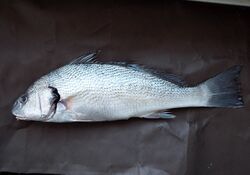Biology:Umbrina cirrosa
| Umbrina cirrosa | |
|---|---|

| |
| Umbrina cirrosa Acquario di Genova | |
| Scientific classification | |
| Script error: No such module "Taxobox ranks".: | Animalia |
| Script error: No such module "Taxobox ranks".: | Chordata |
| Script error: No such module "Taxobox ranks".: | Actinopterygii |
| Script error: No such module "Taxobox ranks".: | Acanthuriformes |
| Script error: No such module "Taxobox ranks".: | Sciaenidae |
| Script error: No such module "Taxobox ranks".: | Umbrina |
| Script error: No such module "Taxobox ranks".: | <div style="display:inline" class="script error: no such module "taxobox ranks".">U. cirrosa |
| Binomial name | |
| Umbrina cirrosa | |
| Synonyms[2] | |
| |
Umbrina cirrosa, the shi drum, is a species of marine fish from the warmer waters of the eastern Atlantic Ocean, Mediterranean Sea and the Black Sea. It is a commercially important species which is trawled for and farmed in aquaculture, as well as being a species pursued by anglers and spear fishermen for sport. The alternative vernacular names are gurbell, sea crow, bearded umbrine and corb.
Description
Umbrina cirrosa has a moderately elongated body which is deep and laterally compressed. Its small mouth has an inferior setting and contains villiform teeth while on its chin there is a short and rigid barbel which is perforated by a pore at its tip. Its scales are mainly ctenoid in form except for those on the breast, snout and sub-orbital region, where they are predominantly cycloid. It is greyish-silver to brownish in colour, with a metallic sheen and is marked with longitudinal dark lines on the dorsal regions; the membranes on hind margin of gill cover are jet black in colour while the fins are dusky.[3] The maximum length recorded is 73 cm total length, although the average is 40 cm.[2]

Distribution
Umbrina cirrosa is found in the eastern Atlantic Ocean from the Bay of Biscay to southern Morocco and in the Mediterranean, although it is not found around the larger islands, and Black Sea and Sea of Azov.[1] It has also spread into the Gulf of Suez through the Suez Canal,[3] one of the few Lessepsian migrants to go from the Mediterranean to the Red Sea, known as anti-Lessepsian migrants.[4]
Habitat and behaviour
Umbrina cirrosa is a demersal species which is found in inshore waters,[3] over both rock and sandy sea beds.[1] The juveniles occur in estuaries.[2] The males produce pulses of sound to attract the females[5] and spawning begins in May and peaks in June,[1] the eggs being scattered over the substrate, each female lays more than one batch of spawn.[2] The prey taken by this species includes sardines, anchovies, mackerels, cuttlefish, molluscs and worms,[1] but the main prey are benthic invertebrates.[3]
Fisheries
Umbrina cirrosa has been recorded as being landed by fishermen in seven Mediterranean countries, the largest catches have been in Turkey and Italy. There has been a steep decline in landings in these two countries over the last ten years. The average landing figures for the years 1986 to 1990 were 1,393t and this has declined by 80% compared with the average figures for the years 2001 to 2005 being 278t.[1] In the European Union over 1,000t was landed in 1995 but this had fallen to less than 100t by 2008.[6] The species is now being farmed in aquaculture in countries such a Cyprus.[7] The European record for a fish caught by an angler is 11.2 kg, this fish was caught in 1992 off Corsica.[8] This species is also pursued by spear fishers.[9]
References
- ↑ 1.0 1.1 1.2 1.3 1.4 1.5 Bizsel, K.; Pollard, D.A.; Yokes, B.; Goren, M.; Chao, L.; Di Natale, A.; Kara, M. (2020). "Umbrina cirrosa". IUCN Red List of Threatened Species 2020: e.T198709A131127681. doi:10.2305/IUCN.UK.2020-1.RLTS.T198709A131127681.en. https://www.iucnredlist.org/species/198709/131127681. Retrieved 11 November 2021.
- ↑ 2.0 2.1 2.2 2.3 2.4 "Umbrina cirrosa (Linnaeus, 1758)". Fishbase.org. http://www.fishbase.org/summary/Umbrina-cirrosa.
- ↑ 3.0 3.1 3.2 3.3 "Fishes of the NE Atlantic and Mediterranean - Shi Drum (Umbrina cirrosa)". Marine Species Identification Portal. ETI BioInformatics. http://species-identification.org/species.php?species_group=fnam&id=1866.
- ↑ Esmaile A. Shakman (2008). Lessepsian Migrant fish Species of the Coastal Waters of Libya: Status, Biology, Ecology (M.Sc.). Universität Rostock.
- ↑ M. Picciulin; M. Bolgan; A.B. Corò; G. Calcagno; S. Malavasi (2016). "Sound production by the Shi drum Umbrina cirrosa and comparison with the brown meagre Sciaena umbra: a passive acoustic monitoring perspective (abstract)". Journal of Fish Biology 88 (4): 1655–1660. doi:10.1111/jfb.12926. PMID 26953119.
- ↑ "Catches - Total all fishing areas". Knoema. https://knoema.com/wxrhend/catches-total-all-fishing-areas?geo=1000310-cyprus&species=1002300-shi-drum-umbrina-cirrosa.
- ↑ "A different kettle of fish! An insight into the offshore fisheries of Cyprus". Cyprus High Commission Trade Centre. http://www.cyprustrade.co.uk/uploadfiles/Articles/isnsept10.pdf.
- ↑ "Ombrine (UMBRINA CIRROSA)". European Federation of Sea Anglers. http://www.efsa.co.uk/record/ombrine.htm.
- ↑ J. Coll; M. Linde; A. Garcia-Rubies; F. Riera; A.M. Grau (2004). "Spear fishing in the Balearic Islands (west central Mediterranean): species affected and catch evolution during the period 1975–2001". Fisheries Research 70: 97–111. doi:10.1016/j.fishres.2004.05.004. http://www.roquer.org/docs/linde1.pdf.
Wikidata ☰ Q136399 entry

